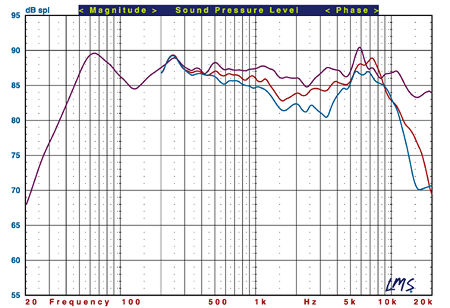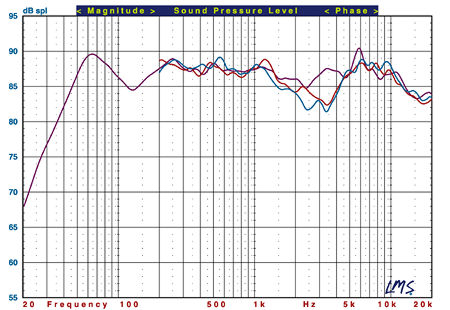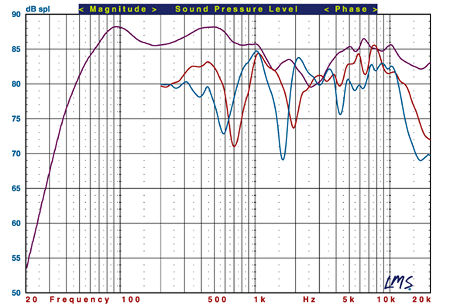Focal-JMlab Diva Utopia Be Surround Speaker System Measurements
The Focal-JMlab Diva Utopia Be's ported enclosure was tuned to approximately 27Hz, with minimum impedance of 3.38 ohms at 100Hz. I would judge this speaker to be of average difficulty to drive for any amplifier comfortable with a 4 ohm load, and I would rate its nominal impedance at 4 ohms. The speaker's sensitivity measured approximately 87dB/2.83V/m.
The horizontal front response of the Diva is shown in Fig.1 (violet). This is the pseudo-anechoic response averaged over a 30-degree forward horizontal angle (+/-15 degrees), at tweeter height, combined with the nearfield responses of the woofer and port. The effective lower limit of the speaker was 35Hz (-10dB relative to the peak output at 64Hz).
All figures: Violet curve: pseudo-anechoic response on tweeter axis, averaged across a 30-degree horizontal window, combined with nearfield woofer and port responses. All measurements taken at 1 meter.

Fig.1: Focal-JMlab Diva Utopia Be, pseudo-anechoic response off the horizontal axis at 45 degrees (red) and 60 degrees (blue).
The averaged front horizontal response of the Diva fell comfortably within a window of +/-3dB from 45Hz-20kHz, apart from a narrow peak at just under 6kHz that rose about 3dB higher than the level around it. There was a slight leaning-out of the response in the upper bass, the nature of which suggests that the midrange driver was rolling off a little too early at its bottom end for optimum blending with the woofer at the 100Hz crossover point.
The speaker's off-axis performance also showed a significant dip through the low treble at far off-axis angles. This dip returned to the midrange level at higher frequencies, but because the dip likely results in less overall output from the speaker in the low treble than in the higher, mid-treble region, the overall room response is likely to be somewhat elevated in that mid-treble range. This may explain the slightly elevated top end I heard on some (but not all) program material.
The vertical response shown in Fig.2 indicates that the Diva should sound best if the listener's ears are positioned on the tweeter axis; move above or below it and the response dips measurably in the 1-3kHz region.

Fig.2: Focal-JMlab Diva Utopia Be, pseudo-anechoic response at 15 degrees above (red) and 15 degrees below (blue) the tweeter.
The Focal-JMlab Center Utopia Be's cabinet was tuned to about 41Hz. Its minimum impedance was 3.7 ohms at 92Hz. I would rate the nominal impedance at 5 ohms. The speaker should be of average difficulty to drive, assuming an amplifier competent into a 4 ohm load. It sensitivity measured about 86dB/2.83V/m.
The measured front horizontal response of the Center Utopia Be, taken on the tweeter axis and averaged in the same manner as described above for the Diva, is shown in Fig.3. The speaker's effective lower limit (-10dB) was approximately 43Hz relative to its output at 100Hz.

Fig.3: Focal-JMlab Center Utopia Be, pseudo-anechoic response off the horizontal axis at 45 degrees (red) and 60 degrees (blue).
The measured frequency response of the Center was significantly different than the Diva's. Other than a dip from 1kHz to 4kHz, it was actually flatter than the Diva on-axis. But that dip falls right in the most sensitive range of human hearing as well as the frequency range of many consonants, wherein the meaning of language resides. The Center's off-axis response was very uneven—a typical result for a speaker using a horizontal woofer-tweeter-woofer configuration.
Interestingly, the vertical off-axis response of the Center (Fig.4) showed a much flatter response than directly on axis, with the upper midrange/lower treble dip virtually gone, leaving only some small ripples in the response that may well have been due to diffraction from the multi-angled cabinet configuration. This sensitivity to vertical placement may explain why I heard such coherent sound from the system from my listening position; I was probably closer to the flatter-response axis.

Fig.4: Focal-JMlab Center Utopia Be, pseudo-anechoic response at 15 degrees above (red) and 15 degrees below (blue) tweeter.
The Diva Utopia Be—and more particularly the Center Utopia Be—produced a mixed set of measurements. This isn't unusual in high-end speakers. But as is often the case in such situations, the Diva system sounds far better than its measurements would suggest.—TJN





























































